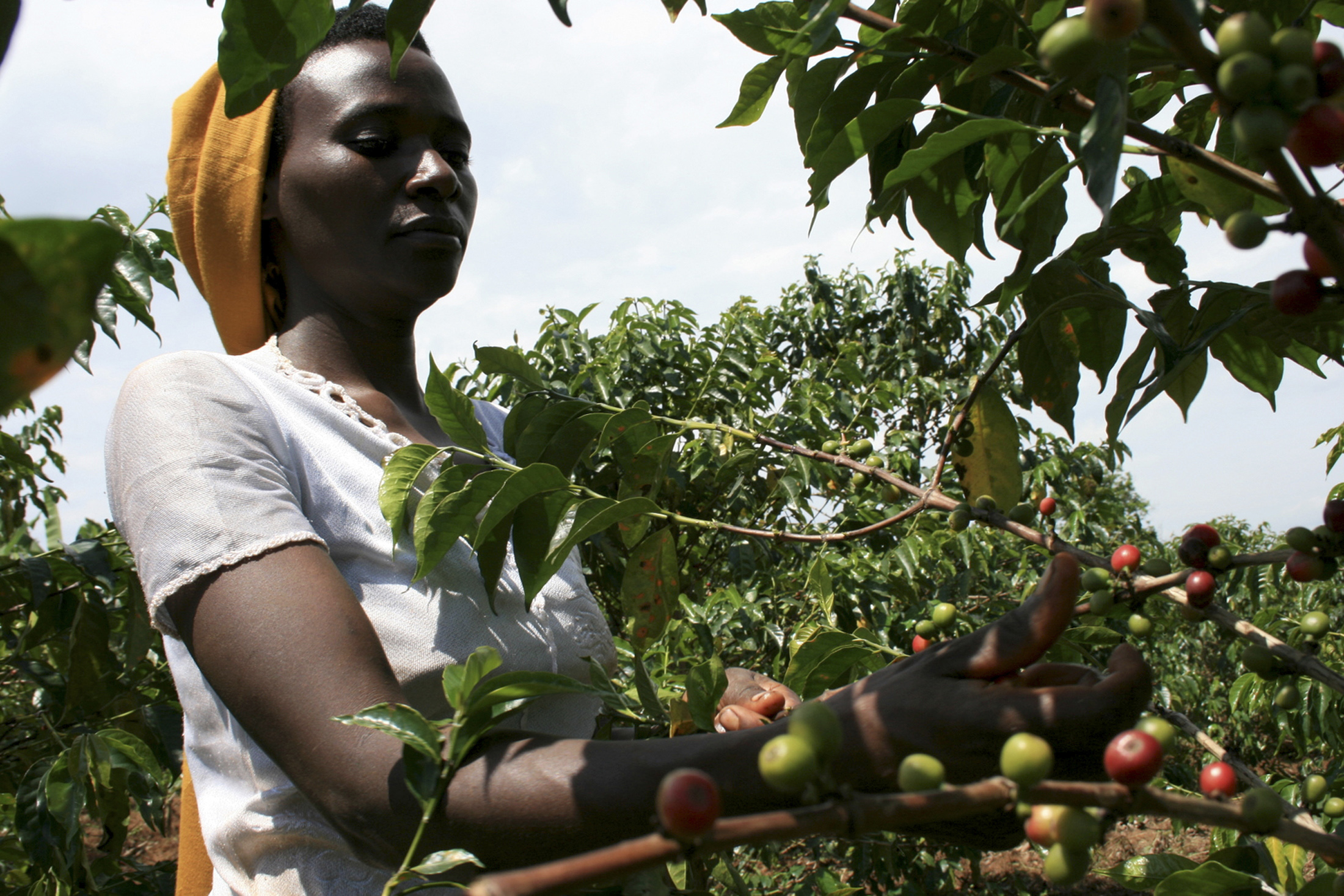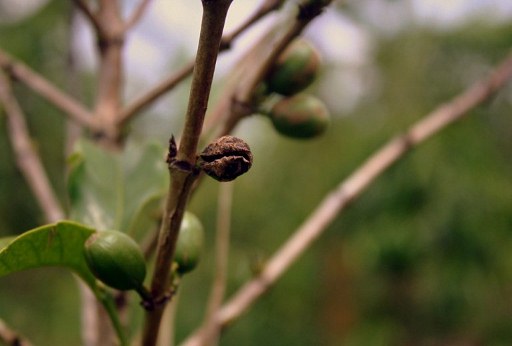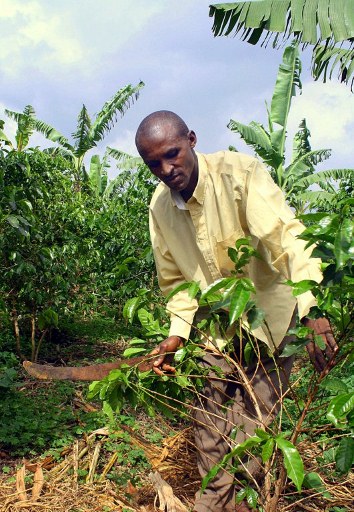In a remote corner of eastern Rwanda, farmer Louis Ntiricakeza hacked at the trunk of one of his banana trees with a small, rusty machete.
Pointing to the pieces of bark scattering on the ground he explained his technique, a process that offers hope against impending climate change.
"We cut the bark from the banana trees to fertilise the coffee," he said, calmly moving to the next in a line of trees that tower not only over the coffee bushes but also most buildings in this village.
Farms like this one, on which cash crops like coffee share soil with food-crops like bananas, could be vital to the future of central Africa's volatile Great Lakes region, according to scientists from the International Institute of Tropical Agriculture (IITA) --a non-profit research group working on solutions for hunger, malnutrition and poverty -- and the Rwandan government.

Luis Ntiricakeza hacking at the trunk of one of his banana trees with a small, rusty machete at his farm in Sakara Village, Eastern Rwanda. ©AFP
The temperature here is expected to increase by about two degrees C (35 degrees F) over the next three or four decades -- a change that could devastate some crops in what is already the continent’s most densely populated region.
Scientists say if aggressive, innovative farming techniques -- like the method on Ntiricakeza's farm called "inter-cropping" -- are not adopted swiftly, the people will suffer.
"We have to be bold -- the consequences are difficult to contemplate," said Sanginga Nteranya, the incoming IITA general director, in an interview in Rwanda's capital, Kigali.
The Great Lakes region has been a theatre of repeated violence since the 1990s -- with a civil war in Burundi in 1993, the Rwandan genocide in 1994, and rebellions and wars in the Democratic Republic of Congo from 1996 to 1997 and 1998 to 2003 --and Nteranya said lack of land was contributing to the unrest.
 A farmer picks coffee bean cherries in the outskirts of the capital Kigali Rwanda. ©REUTERS
A farmer picks coffee bean cherries in the outskirts of the capital Kigali Rwanda. ©REUTERS
"So intensification and real investment in agriculture is the key to feeding the population... not only feeding the population but preventing those wars," he said.
Around the world, scientists and farmers are scrambling to develop crops that not only are more resilient to erratic weather but also yield more food per plot of land, to accommodate population growth.
-- Minimise risk --
Laurence Jassogne, an agricultural systems scientist with a group called the Consortium for Improving Agriculture-based Livelihoods in Central Africa, said that if implemented successfully, inter-cropping could be one of the answers.
The process leads to larger coffee harvests per hectare (2.4 acres), and the coffee -- the more fragile of the two plants -- is protected from the sun by banana trees.

A coffee bush at the farm of Rwanda's Luis Ntiricakeza in Sakara Village, Eastern Rwanda. ©AFP
Banana trees also trap carbon, reducing the carbon footprint of the coffee sold on the shelves, added Jassogne.
In Rwanda, some officials believe the banana-coffee scheme could also boost the economy in the short term.
Near the village, Martin Simon, a researcher for Rwanda’s Agriculture Board, said that inter-cropping is already popular in Tanzania and Uganda.
"When you plant coffee for the first time, before you can harvest it takes three to four years," he said while showing off another farm set up to experiment with banana-coffee fields. "Inter-cropping will lead to revenue generation after four years from coffee, and in the meantime you will be harvesting banana for food consumption."
Other officials are more cautious, saying further research is needed before Rwanda changes its agricultural policy, which has long encouraged farmers to grow single crops.
Celestin Gatarayiha, the head of the coffee division at the National Export Development Board who was among those who initiated the inter-cropping study, said no changes will be made before research is completed.
 Luis Ntiricakeza tending to his farm in Sakara Village, Eastern Rwanda. ©AFP
Luis Ntiricakeza tending to his farm in Sakara Village, Eastern Rwanda. ©AFP
"If it is not done well, we are scared of competition from the two crops," he said, warning that yields for both could suffer if they are planted in the wrong proportions.
Other countries, like neighbouring Burundi where food is scare, are watching but moving slowly on the initiative.
Coffee is essential to Burundi's economy even if it does not fill bellies, said Jassogne. But the Burundian government "wants to minimise the risk they are taking on because coffee is so important to their economy."
Some farmers, meanwhile, are pleased with results but fatalistic about climate change.
Ntiricakeza, one of the few who already grew both bananas and coffee on his land, is happy his income has tripled since he started inter-cropping, but preparing for climate change was not part of his agenda.
"There’s nothing to do, it’s just God’s plan," he said outside his clay house. "If it rains, we harvest. If it doesn’t rain, there is drought."
Source: AFP














